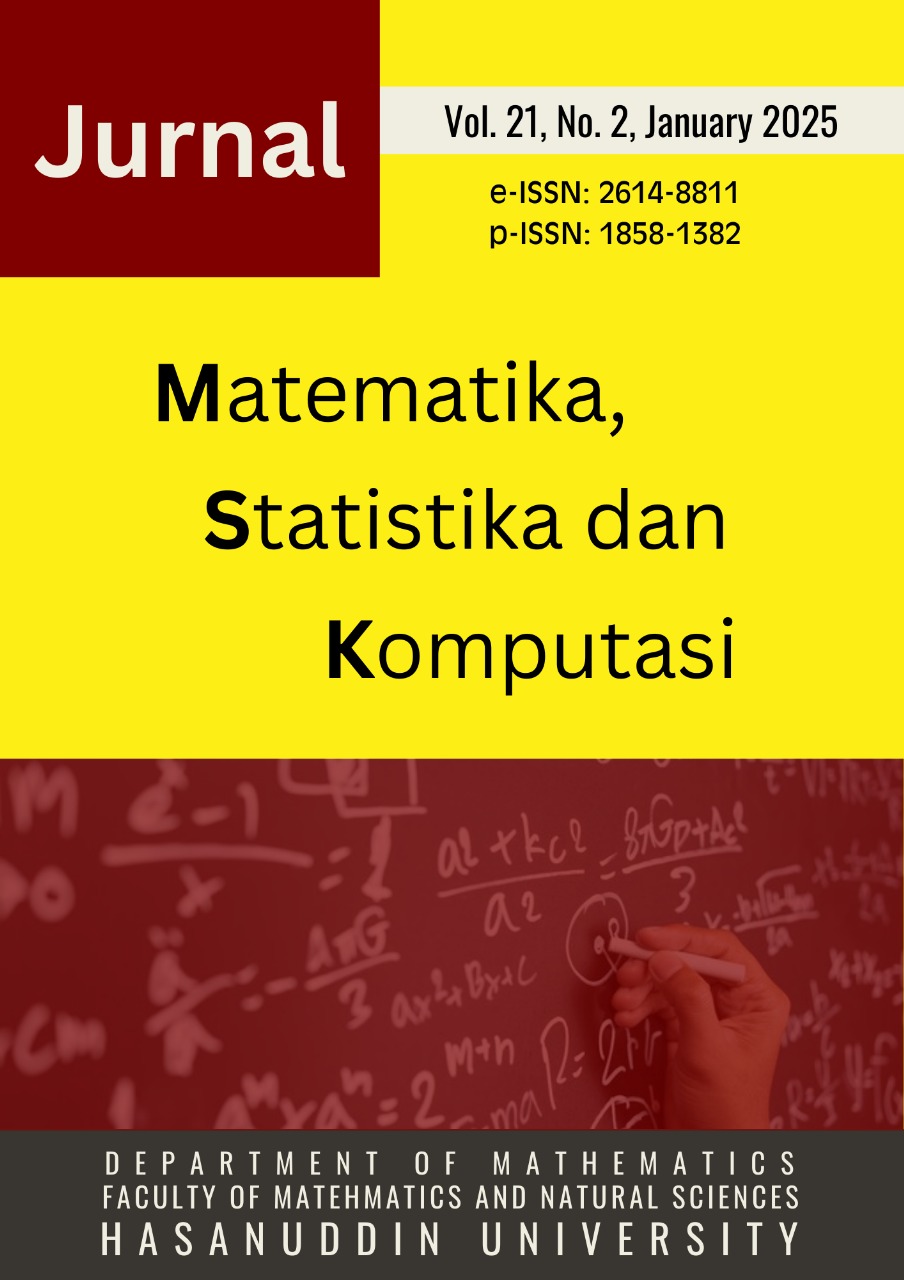Community Detection, Topic, and Sentiment Analysis of the Palestine-Israel Issue on Social Media X
DOI:
https://doi.org/10.20956/j.v21i2.41308Keywords:
Community Detection, Leiden, LDA, IndoBERT, Palestine-IsraelAbstract
The combination of community detection, topic modeling, and sentiment analysis provides deep insights into conversation data on the social media platform X (formerly Twitter) regarding the Palestine-Israel issue. The data, collected in Indonesian using several keywords, resulted in 108,969 tweets. The analysis process began with community detection using the Leiden algorithm, which identified five communities. The three dominant communities identified are Community 1 comprising 37.13% of users, Community 2 with 26.95%, and Community 3 with 19.76%. Topic modeling using LDA revealed that these communities focused on various aspects of the conflict. Sentiment analysis using the IndoBERT model uncovered that the majority of users expressed negative attitudes such as disappointment and anger. This study provides insights into public opinions and social dynamics surrounding the conflict.
References
[1] Ahmad Rifai, Eka Putri Rachmawati, & Dinar Anggit Wicaksono., 2022. Social Network Analysis dalam Mengukur Keaktifan Promosi Universitas di Media Sosial Twitter. The Indonesian Journal of Computer Science, 11(3). https://doi.org/10.33022/ijcs.v11i3.3097
[2] D. Wood, I., Glover, J., & Buitelaar, P., 2020. Community Topic Usage in Online Social Media. ACM Transactions on Social Computing, 3(3). https://doi.org/10.1145/3403616
[3] Devlin, J., Chang, M.-W., Lee, K., & Toutanova, K., 2019. BERT: Pre-training of Deep Bidirectional Transformers for Language Understanding (arXiv:1810.04805). arXiv. http://arxiv.org/abs/1810.04805
[4] Dikiyanti, T. D., Rukmi, A. M., & Irawan, M. I., 2021. Sentiment analysis and topic modeling of BPJS Kesehatan based on twitter crawling data using Indonesian Sentiment Lexicon and Latent Dirichlet Allocation algorithm. Journal of Physics: Conference Series, 1821(1), 012054. https://doi.org/10.1088/1742-6596/1821/1/012054
[5] Gautam, V., & Gupta, S., 2023. Envisaging Modularity Detecting Communities in Networks: Gephi Visuals. Evergreen, 10(4), 2390–2397. https://doi.org/10.5109/7160929
[6] Hairol Anuar, S. H., Abal Abas, Z., Md Yunos, N., Mukhtar, M. F., Setiadi, T., & Shibghatullah, A. S., 2024. Identifying Communities with Modularity Metric Using Louvain and Leiden Algorithms. Pertanika Journal of Science and Technology, 32(3), 1285–1300. https://doi.org/10.47836/pjst.32.3.16
[7] Hairol Anuar, S. H., Abas, Z. A., Yunos, N. M., Mohd Zaki, N. H., Hashim, N. A., Mokhtar, M. F., Asmai, S. A., Abidin, Z. Z., & Nizam, A. F., 2021. Comparison between Louvain and Leiden Algorithm for Network Structure: A Review. Journal of Physics: Conference Series, 2129(1), 012028. https://doi.org/10.1088/1742-6596/2129/1/012028
[8] Imaduddin, H., A’la, F. Y., & Nugroho, Y. S., 2023. Sentiment Analysis in Indonesian Healthcare Applications using IndoBERT Approach. International Journal of Advanced Computer Science and Applications, 14(8). https://doi.org/10.14569/IJACSA.2023.0140813
[9] Kannitha, D. Z. T., Mustafid, M., & Kartikasari, P., 2022. Pemodelan Topik pada Keluhan Pelanggan Menggunakan Algoritma Latent Dirichlet Allocation dalam Media Sosial Twitter. Jurnal Gaussian, 11(2), 266–277. https://doi.org/10.14710/j.gauss.v11i2.35474
[10] Kurniawan, A., Nugroho, A., & Al Azam, M. N., 2019. Analisis Jejaring Sosial Tokoh Publik Menggunakan Metode GrapML. JOINTECS (Journal of Information Technology and Computer Science), 4(3), 123. https://doi.org/10.31328/jointecs.v4i3.1208
[11] Patmawati, P., & Yusuf, M., 2021. Analisis Topik Modelling Terhadap Penggunaan Sosial Media Twitter oleh Pejabat Negara. Building of Informatics, Technology and Science (BITS), 3(3), 122–129. https://doi.org/10.47065/bits.v3i3.1012
[12] Rashif, F., Nirvana, G. I. P., Noor, M. A., & Aini, N., 2021. Implementasi LDA untuk Pengelompokan Topik Tweet Akun Bot Twitter bertagar #Covid-19. 7.
[13] Saadah, S., Kaenova Mahendra Auditama, Ananda Affan Fattahila, Fendi Irfan Amorokhman, Annisa Aditsania, & Aniq Atiqi Rohmawati, 2022. Implementation of BERT, IndoBERT, and CNN-LSTM in Classifying Public Opinion about COVID-19 Vaccine in Indonesia. Jurnal RESTI (Rekayasa Sistem Dan Teknologi Informasi), 6(4), 648–655. https://doi.org/10.29207/resti.v6i4.4215
[14] Sanandres, E., Lianos, R. A., & Alberto Madariaga Orozco, C., 2020. Topic Modeling of Twitter Conversations: The Case of the National University of Colombia. Text Analytics, Advances and Challenges, 241–251. https://doi.org/10.1007/978-3-030-52680-1_19
[15] Schneider, K., & Mühlhaus, T., 2019. FSharpGephiStreamer: An idiomatic bridge between F# and network visualization. Journal of Open Source Software, 4(38), 1445. https://doi.org/10.21105/joss.01445
[16] Sliwa, K., Kusen, E., & Strembreck, M., 2024. A Case Study Comparing Twitter Communities Detected by the Louvain and Leiden Algorithms During the 2022 War in Ukraine. 1376–1381. https://doi.org/10.1145/3589335.3651892
[17] Traag, V. A., Waltman, L., & Van Eck, N. J., 2019. From Louvain to Leiden: Guaranteeing well-connected communities. Scientific Reports, 9(1), 5233. https://doi.org/10.1038/s41598-019-41695-z
[18] Wijaya, D. R., Sasmita, G. M. A., & Vihikan, W. O., 2024. Sentiment Analysis of Indonesian Citizens on Electric Vehicle Using FastText and BERT Method. 6(3).
[19] Wilie, B., Vincentio, K., Winata, G. I., Cahyawijaya, S., Li, X., Lim, Z. Y., Soleman, S., Mahendra, R., Fung, P., Bahar, S., & Purwarianti, A., 2020. IndoNLU: Benchmark and Resources for Evaluating Indonesian Natural Language Understanding (arXiv:2009.05387). arXiv. http://arxiv.org/abs/2009.05387
[20] Yan, S., Jia, Y., & Wang, X., 2021. Overlapping Community Detection in Temporal Text Networks (arXiv:2101.05137). arXiv. http://arxiv.org/abs/2101.05137
Downloads
Published
How to Cite
Issue
Section
License
Copyright (c) 2025 Jurnal Matematika, Statistika dan Komputasi

This work is licensed under a Creative Commons Attribution 4.0 International License.

This work is licensed under a Creative Commons Attribution 4.0 International License.
Jurnal Matematika, Statistika dan Komputasi is an Open Access journal, all articles are distributed under the terms of the Creative Commons Attribution License, allowing third parties to copy and redistribute the material in any medium or format, transform, and build upon the material, provided the original work is properly cited and states its license. This license allows authors and readers to use all articles, data sets, graphics and appendices in data mining applications, search engines, web sites, blogs and other platforms by providing appropriate reference.







